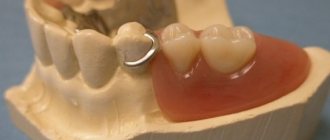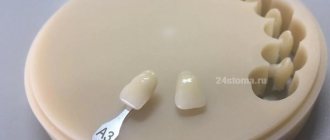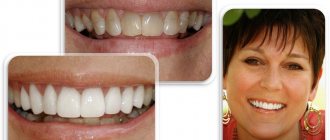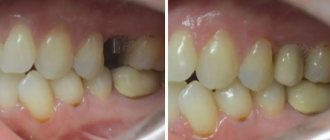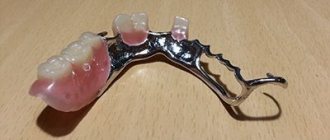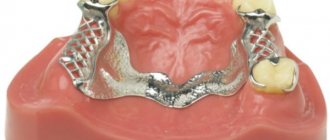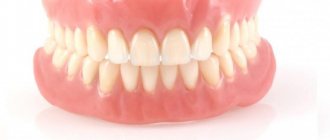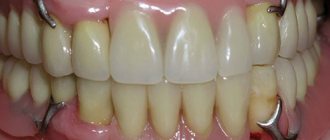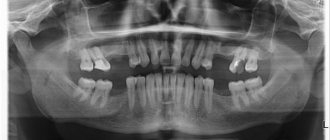From this article you will learn:
- what is a clasp dental prosthesis,
- its variants for the upper and lower jaw,
- types of fixation on abutment teeth,
- price of a clasp prosthesis for 2022.
Clasp denture is the best option for removable prosthetics, used only in cases of partial absence of teeth. This type of prosthesis gets its name from the German word “bugel,” which means “arch.” Accordingly, it will be distinguished from traditional dentures made of plastic or nylon by the presence of a metal frame, to which (in the area of missing teeth) a base with artificial teeth will be welded (Fig. 1).
The base is the part of the prosthesis in which the artificial teeth are located (it is made of acrylic plastic, less often - of nylon or Acry-free material). The metal frame gives additional strength to the structure, which allows you to significantly reduce the volume and thickness of the plastic base of the removable denture. This means - 1) the prosthesis will occupy less volume in the oral cavity, 2) you will quickly get used to it, 3) wearing the prosthesis will be more convenient and comfortable.
What is a clasp prosthesis?
Clasp dental prosthetics is a widely used treatment method in orthopedic dentistry. Designed to restore teeth in both the lower and upper jaws. The name itself comes from the German “bugel”, which means “arc”, that is, bugel - literally “having an arc”. The design of clasp dentures includes a metal or plastic arch, artificial teeth that are attached to a base that imitates gums, and fixing elements in the form of hooks, clasps or crowns.
Stages of making a clasp prosthesis
Based on the principle of making the frame, the clasp prosthesis is divided into several types: soldered, solid-cast, milled, and based on laser sintering of nanoparticles of a special metal alloy powder. The last two methods are considered the most progressive and allow you to create a high-precision (up to 10 microns) and comfortable design.
Manufacturing takes place in 4 stages:
- first the dental technician creates a plaster model
- Based on the plaster model, a prototype of the prosthesis is cast and scanned
- using the scan, the frame of the clasp structure is modeled on a computer
- the prosthesis is ultimately sintered or milled.
The result exceeds all expectations - the prosthesis fits tightly to the gums and teeth, does not break and looks very aesthetically pleasing.
Design Features
Splinting structures have a number of features:
- the base , made of plastic or a combined material, is distinguished by its reduced size, which facilitates rapid adaptation to a foreign body in the mouth and comfortable wearing;
- according to the method of installation, the products are removable and non-removable (the former are easily put on and removed by the patient independently, and the latter are fixed for a long time, subject to constant wear for 2-6 months);
- according to production technology, structures are either solid-cast or soldered (in the first case, a non-separable frame is used, the second option involves stage-by-stage production with subsequent assembly);
- the base part does not come into contact with the palate, which eliminates distortion of speech or taste sensations;
- splinting products prevent bone tissue atrophy; while chewing food, the load is redirected to the entire jaw;
- products are highly durable;
- the design helps restore the anatomy of the dental system.
Indications for clasp prosthetics
The main indication for clasp dentures is the inability to install dentures on implants and the presence of at least several supporting teeth to which it could be secured. Partial structures are most often used both to replace several teeth with terminal defects and to restore a single tooth.
Whereas the clasp upper and lower denture completely reproduces the entire dentition. In addition, there is a splinting clasp prosthesis, which is used as a structure that restores and supports teeth. The prosthesis splints teeth affected by periodontitis or periodontal disease from the inside, replaces missing parts of the dentition and prevents the occurrence of adentia and prolongs the performance of the affected teeth.
Contraindications include:
- oral diseases in the acute stage
- increased tooth wear
- diseases leading to bone loss
- low or missing abutment teeth
- deep bite
- chronic neurological and mental diseases
- short frenulum of the tongue
- shallow floor of the mouth
- allergy to metal or other materials used in the design
Contraindications
Nylon prostheses have a small number of contraindications, but in some cases specialists prohibit their installation. This includes the following cases:
Periodontal disease is prolonged, complicated and of high degrees 3rd and 4th. With this disease, the tissues surrounding the tooth are completely destroyed, the dentition is significantly displaced, and purulent ulcers appear on the gums of both jaws. Such a patient is at risk of edentia - complete loss of teeth.
The teeth on which dentures will need to be fixed are small and have a low crown. This situation significantly complicates prosthetics, since it is difficult to install the structure on them - the attachment area is small.
An inflammatory process involving the oral mucosa, as well as developed inflammation of the gums of one or both jaws. The chronic course of the disease causes tissue atrophy, and it can be very difficult to fix the prosthesis.
High gum mobility in the patient also causes difficulties with the installation of the prosthesis.
Large-scale atrophy of the jaw bone tissue.
Recession is the receding or overgrowth of gum tissue.
Types of clasp dentures
Clasp dentures are also divided according to the method of their attachment to the supporting teeth. Unlike completely removable structures, which are fixed by suction to the gum or using special adhesives, fixation and installation of clasp dentures occurs using several types of fastening.
On clasps
Clasp dentures with clasps consist of metal hooks that clasp the abutment tooth in the neck area. The clasp clasp prosthesis is attached without grinding down the enamel, provided that the supporting teeth are not destroyed or affected by severe caries. However, this type is not aesthetic enough - the hooks are noticeable when you smile.
On locks or attachments
A locking clasp prosthesis consists of two parts, one of which is attached to the ground abutment teeth, and the second with the help of locks to the prosthesis itself. Unlike other types, a clasp denture with attachments is more immobile, so the load is distributed evenly on the supporting teeth and the alveolar mucosa.
Clasp prosthesis on telescopic crowns
When installing a clasp prosthesis on telescopic crowns, first fixed metal crowns are placed on the supporting teeth, and then ceramic crowns are placed in the prosthesis.
Alternatives
Alternative options include:
- Elastic prosthetic structures Akri-Free are aesthetic, comfortable removable dentures, recommended for patients with complete edentia.
- New generation acrylic structures - diamond chips are added to acrylic plastic, which makes the orthopedic system more durable.
- Quadrotti is an arc structure (clasp) in which metal components are not used. Made from durable DENTAL D
, capable of withstanding high impact loads.
None of the listed removable structures are used for tooth mobility. Only clasp-type prostheses provide a splinting effect due to the cast frame. You need to know that removable prosthetics does not solve the problem of jawbone atrophy. Dental implantation will allow you to preserve its volume.
Article Expert
Alekperov Roman Borisovich Dentist-orthopedist, doctor of the highest category
Work experience: more than 32 years
Nylon clasp quadrotti prosthesis
A product of the Italian company Quattro Ti, the quadrotti clasp prosthesis is very similar to a removable nylon prosthesis, with the only difference being that during its manufacture, nylon is mixed with hypoallergenic plastic. The resulting material has a number of advantages: it is more durable than nylon, and artificial teeth do not show through it. According to the manufacturers, this type of metal-free clasp prosthesis does not deform over time, does not cause discomfort when worn, and looks much more aesthetically pleasing than other prostheses. A soft prosthesis is attached to the teeth using plastic clasps, or saddles, covered on top with the same material as the base of the prosthesis. Saddles can be either pink or white, making them unnoticeable on the teeth. As for the disadvantages of the prosthesis, firstly, Quattro Ti is not strong enough, since no matter how strong the plastic is, it cannot be compared with metal. Secondly, a clasp prosthesis with nylon saddles requires special care using special means, which requires additional costs and cannot be repaired.
Caring for clasp dentures
Getting used to the clasp denture may take a couple of days. At first it will be somewhat uncomfortable for you to talk, so you will have to get rid of speech defects with the help of special exercises. Eating will also cause some difficulties. At first, to minimize pain, it is best to divide food into small portions and exclude very hard foods and sticky sweets from the diet. In order to quickly get used to the prosthesis, do not take it off at night.
Twice a day (morning, evening) it is necessary to remove the clasp prosthesis and clean it of plaque using the means recommended by the doctor, and also rinse it in a special antibacterial solution.
The clasp denture should be stored in a container, but not in water. Some types of structures, for example, soft quadrotti dentures, require special care, otherwise they fade and look unsightly on the teeth.
Advantages and disadvantages
For comparison, let’s take the clasp’s “classmates” - fixed bridges and removable plate prostheses. Clasp orthopedic structures, of course, are superior to plate ones in strength, but, like bridges, they are a temporary way to restore the dentition. Despite all the efforts of manufacturers, the clasp is not able to stop the loss of bone tissue, the inevitable decrease of which soon leads to changes in facial features and disturbances in the functioning of the dental system and internal organs. The obvious disadvantages of a removable clasp also include an aesthetic defect when installing a clasp prosthesis, when metal hooks attached to the teeth are visible, and a slow adaptation time to the design. In addition, any denture puts pressure on the gums and causes discomfort when chewing and hypoxia - a condition in which the gums do not have enough nutrition, which causes bone tissue to atrophy even faster. As for the service life of clasp dentures, compared to dental implants, it is quite short and is no more than 10 years. Subject to proper care and timely correction once a year.
Read also
Removable dentures: which ones are better?
Dental restoration using removable dentures can be an alternative to fixed structures.
What to do after tooth extraction: recommendations
Tooth extraction is an invasive dental procedure that requires a recovery period.
How much does partial denture cost?
The average cost of clasp dentures in Moscow consists of the cost of the material, the work of the dental technician and the method of attachment to the supporting teeth. So, despite their popularity, the cost of nylon quadrotti dentures for one jaw is approximately the same as the price of clasp dentures - from 45,000 rubles and more. Clasp dentures with locks are somewhat more expensive - from 35,000 to 80,000 rubles. The most expensive of removable structures are considered to be dentures with telescopic crowns - their price ranges from 100,000 rubles to 200,000 rubles and more. As for clasp dentures on implants, their cost starts from 90,000 to 200,000 rubles and more, depending on the number of implants installed. If you decide to have a clasp prosthesis installed, then choose trusted clinics here.
High-quality clasp prosthetics is a worthy alternative to implantation, and in times of economic depression, clasp prosthetics is the most optimal option for restoring missing teeth.
Prices
| Service | Price |
| Consultation + treatment plan | |
| Clasp prosthesis | 47 700 ₽ |
| Lock prosthesis | 50 200 ₽ |
| Quadrotti | from 57,100 ₽ |
| Splinting | 52 150 ₽ |
Expert of the article you are reading: Akhtuba Daria Dmitrievna Orthopedic dentist, leading specialist of the NovaDent network
12 years
Clinical experience
Academic
st. Dmitry Ulyanov, 36
+7
Free consultation with this specialist
